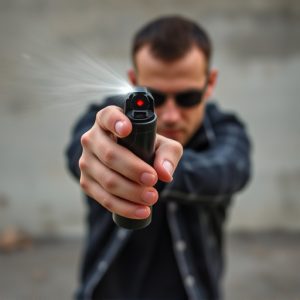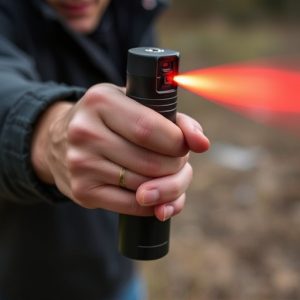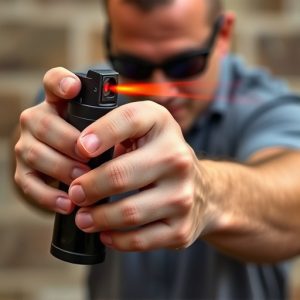Mastering Non-Lethal Pepper Spray: Best Self-Defense Techniques and Legal Considerations
Mastering the best pepper spray self-defense techniques involves strategic deployment, aiming at sen…….
Mastering the best pepper spray self-defense techniques involves strategic deployment, aiming at sensitive areas like eyes, nose, and mouth, for immediate discomfort and temporary blindness. With proper training, practice, and understanding of capsaicin's effects, individuals can effectively disable attackers while minimizing harm. Selecting a top-rated pepper spray with high potency (10%+ capsaicin) and ease of use, along with regular practice, ensures accurate deployment in critical situations, balancing personal safety with legal considerations regarding usage and storage.
“Uncover the power of pepper spray as a non-lethal self-defense tool in this comprehensive guide. Learn how this simple yet effective weapon works, exploring its scientific basis and the chemistry behind its numbing effects. Discover the best practices for choosing and mastering pepper spray techniques, ensuring your safety. From understanding legalities to safe handling, we provide essential knowledge for empowering yourself with the best pepper spray self-defense strategies.”
- Understanding Pepper Spray as a Non-Lethal Defense Tool
- The Science Behind Pepper Spray's Effectiveness
- Choosing the Best Pepper Spray for Self-Defense
- Mastering Pepper Spray Application Techniques
- Legal Considerations and Safe Handling Practices
Understanding Pepper Spray as a Non-Lethal Defense Tool
Pepper spray, often hailed as one of the most effective non-lethal self-defense tools, delivers a powerful yet safe deterrent against potential threats. Unlike traditional weapons that can cause serious harm or even death, pepper spray is designed to incapacitate an attacker temporarily, allowing the user time to escape and seek help. When used properly, it can be a game-changer in self-defense strategies, especially for individuals who want to protect themselves without resorting to lethal force.
The key to mastering pepper spray as a self-defense tool lies in understanding its best techniques. Training and practicing the right application methods are crucial. Users should aim for the attacker’s face, eyes, and nose, where the spray can cause the most discomfort and temporary blindness. Knowing how to deploy it quickly and accurately can make all the difference in an emergency situation. Learning these skills ensures that individuals armed with pepper spray are prepared and capable of defending themselves effectively while minimizing risk to others.
The Science Behind Pepper Spray's Effectiveness
Pepper spray, a non-lethal inflammatory self-defense tool, has gained popularity for its effectiveness in deterring potential attackers. The key ingredient, capsaicin, is derived from chili peppers and is responsible for the burning sensation it causes when in contact with the skin or eyes. When used as part of the best pepper spray self-defense techniques, this compound irritates nerve endings, leading to temporary blindness, coughing, and difficulty breathing. This disruption can create enough time for an individual to escape a dangerous situation.
The science behind pepper spray’s effectiveness lies in its ability to target the body’s sensory system. Capsaicin binds to TRPV1 receptors on the skin and eyes, triggering a response that is both painful and irritating. Unlike other self-defense options, pepper spray does not cause permanent damage but instead temporarily incapacitates an assailant, providing individuals with a valuable tool for personal safety. Understanding these mechanisms allows users to employ strategic applications during emergency situations, leveraging the power of this natural compound.
Choosing the Best Pepper Spray for Self-Defense
When selecting a pepper spray for self-defense, understanding your specific needs and environment is key. The best pepper spray should offer a balance between potency and ease of use. Look for sprays with a high capsaicin concentration, typically 10% or more, to ensure maximum effectiveness against attackers.
Consider factors like spray pattern, range, and actuation mechanism. A wide spray pattern covers a larger area, increasing the likelihood of affecting multiple assailants, while a shorter range may be suitable for close-quarters combat. Additionally, practice with your chosen spray using various self-defense techniques to familiarize yourself with its operation and ensure you can deploy it quickly and accurately when needed.
Mastering Pepper Spray Application Techniques
Mastering pepper spray application techniques is crucial for anyone looking to protect themselves with this non-lethal inflammatory self-defense tool. The best pepper spray self-defense techniques involve understanding how and when to deploy it effectively. Aiming for the eyes, nose, and mouth is key; these areas are highly sensitive and experiencing even a brief attack can disable an assailant. Practice different application methods like the “stop” or “swipe” technique to ensure you’re comfortable and accurate under stress.
Regular training sessions with a trusted instructor can help refine your skills, ensuring you use pepper spray responsibly and only when absolutely necessary. Remember, proper usage requires minimal force while maximizing impact, making it an effective yet non-lethal option for self-defense in various scenarios.
Legal Considerations and Safe Handling Practices
When considering non-lethal inflammatory self-defense tools, such as pepper spray, users must be aware of the legal implications and safety protocols in their jurisdiction. The use of pepper spray is regulated by local laws, which vary significantly from place to place. It’s crucial to understand these regulations before purchasing and carrying a pepper spray device. Some areas have strict restrictions on the type, size, and strength of pepper spray allowed, while others may require permits or registration.
Safe handling practices are equally important. Pepper spray can cause severe irritation if mishandled, so users should familiarize themselves with proper usage techniques. This includes learning best Pepper Spray Self Defense Techniques, such as aiming correctly, activating the spray properly, and understanding the range of effectiveness. Additionally, storing pepper spray safely, keeping it out of reach of children and pets, and regularly inspecting for any signs of damage or malfunction are essential precautions to ensure both personal safety and legal compliance.
Pepper spray, as a non-lethal inflammatory self-defense tool, offers individuals a powerful option for personal safety. By understanding its science, choosing the right product, mastering application techniques, and being aware of legal considerations, you can effectively utilize pepper spray as part of your best self-defense strategies. Armed with knowledge and the proper tools, you can protect yourself in various situations, ensuring your safety and peace of mind.


